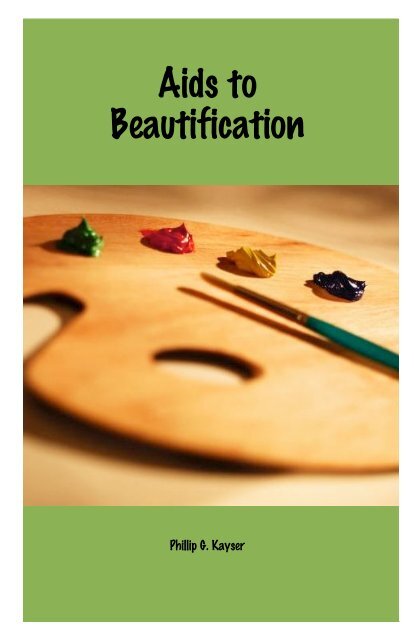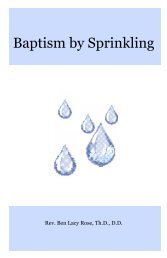Aids to Beautification - Biblical Blueprints
Aids to Beautification - Biblical Blueprints
Aids to Beautification - Biblical Blueprints
You also want an ePaper? Increase the reach of your titles
YUMPU automatically turns print PDFs into web optimized ePapers that Google loves.
<strong>Aids</strong> <strong>to</strong><strong>Beautification</strong>Phillip G. Kayser
Phillip G. Kayser<strong>Aids</strong> <strong>to</strong> <strong>Beautification</strong>Copyright © 2009, 1983 Phillip G. KayserAll Rights Reserved.Published By <strong>Biblical</strong> <strong>Blueprints</strong>13110 Birch Dr • STE 148 #370 • Omaha, NE 68164-4160(402) 934-4619 • www.biblicalblueprints.orgUnless otherwise noted, Scripture quotations are from the Holy Bible,New King James Version. Published by Thomas Nelson. © 1994, 1982,1980, 1979 Thomas Nelson, Inc. Used by Permission.
<strong>Aids</strong> <strong>to</strong> <strong>Beautification</strong>Phillip G. Kayser<strong>Biblical</strong> <strong>Blueprints</strong>Omaha, NE
Contents:Jewelry ............................................................................................1God’s Design ..............................................................................1Perversion of Purposes ...............................................................1Proper Perspective ......................................................................1Precious S<strong>to</strong>nes in the Bible ......................................................2Functional and Aesthetic............................................................4Cosmetics & Perfumes..................................................................6Mistaken Assumptions ...............................................................6God Ordained Purposes..............................................................6Archaeology................................................................................8
Jewelry • 1JewelryPrecious s<strong>to</strong>nes and aromatic resin (see perfume below) weredeliberately created for the benefit of mankind before Adam andEve were even created (Gen. 2:12). Not only were they created,but the gold was said <strong>to</strong> be good (Gen. 2:12); everything increation was declared <strong>to</strong> be very good (Gen. 1:31) and all wasgiven <strong>to</strong> Adam and Eve.God’s DesignIf we are <strong>to</strong> approach life from a simply functional viewpoint,then much of Scripture seems superfluous. Why did God giveAdam and Eve precious and beautiful s<strong>to</strong>nes? Why was Heconcerned about perfume? Why did God decorate the temple solavishly? When God made clothes for Aaron why did He givethe dual purpose as “for glory and for beauty” (Ex. 28:2,40).Why did He give Scripture in so many literary styles? Why didHe make the tree of the knowledge of good and evil desirable <strong>to</strong>look upon? Why did God give us taste buds rather than make useat out of <strong>to</strong>othpaste tubes? He obviously has an interest ingiving us pleasure through beauty.Perversion of PurposesWearing jewelry is treated as evil by many people because ofthe way the ungodly lust after jewels and pervert the beauty <strong>to</strong>ungodly ends. Before Satan fell he was “full of wisdom andperfect in beauty” (Ezek. 28:12). The fact that he allowed thebeauty <strong>to</strong> sinfully get <strong>to</strong> his head (Ezek. 28:17) did not mean thatthe beauty was bad.Proper PerspectiveWhen 1Timothy 2:9 warns about the dangers of costlyclothing, it does not mean that all beauty is spoken against.Otherwise we charge God with folly in creating both the beautyand the desire for beauty. We must remember that God declared
2 • <strong>Aids</strong> <strong>to</strong> <strong>Beautification</strong>jewels as good before the fall, and after the fall God “decoratedthe house with precious s<strong>to</strong>nes for beauty” (2Chron. 3:6). Noother reason is given than that God values beauty and He expectsus <strong>to</strong> value beauty as well.The great marriage Psalm, Psalm 45, delights in the aestheticvalue attributed <strong>to</strong> the jewelry, beautiful clothes, and perfumesworn by the bride and the groom. The Song of Solomon delightsin the natural beauty of man and wife, but it also compares thenatural beauty <strong>to</strong> precious s<strong>to</strong>nes, perfume, etc. (see Song 7 forexample). But the Song of Solomon also sees an added glory inthe natural beauty of the person adorned in man-made beauty.For example, it says not only “you are beautiful” (6:4), but also“How beautiful are your feet in sandals.” The adornment of theperson accentuates the beauty. Some people are naturallybeautiful, but some people need help. Jeremiah 4:30 speaks ofnice clothing, ornaments of gold and eye shadow as ways <strong>to</strong>“make yourself beautiful.” And we will be seeing that Godauthorizes the use of not only jewelry, but also beautiful clothes,cosmetics and perfumes.Jewelry was highly prized in <strong>Biblical</strong> times by both men andwomen (Exodus 11:2; Isa. 3:18-21). Such Jewels were given asgifts (Gen. 24:22,53; 2Chron. 21:3), taken as spoil in war(2Chron. 20:25), and used as a sort of currency (Job 28:16; Prov.3:15; Rev. 21:11). Inscribed seals have been found in cornelian,chalcedony, jasper, agate, onyx, rock crystal, hematite, jade, opaland amethyst. Numerous other ornaments have been found aswell.Precious S<strong>to</strong>nes in the Bibleadamant (or possibly emery, a form of corundum which isthe hardest substance next <strong>to</strong> diamonds - Jer. 17:1; Ezek. 3:9;Zech. 7:12),agate (Ex. 28:19; 39:12), carbuncle (or ruby? Isa. 54:12;Ezek. 27:16),
Jewelry • 3alabaster (ancient alabaster was not usually gypsum, butcarved calcium carbonate - Mark 14:3; Matt. 26:7; Luke7:37),amethyst (Ex. 28:19; 39:12),beryl (Ex. 28:20; 39:13; Song 5:14; Ezek. 1:16; 10:9; 28:13;Dan. 10:6; Rev. 21:20),carbuncle (green in Ex. 28:17; 39:10; Ezek. 28:13 and redin Isa. 54:12),chalcedony (refers <strong>to</strong> various forms of translucent quartzincluding agate, onyx, carnelian and chrysoprase - Rev.21:19),chrysolite (or the modern <strong>to</strong>paz -Rev. 21:20; Ezek. 1:16;10:9; 28:13),chrysoprasus (Rev. 21:20),coral (Job 28:18; Ezek. 27:16),crystal (Job 28:17),diamonds (Ex. 28:18; 29:11; Ezek. 28:13),emerald (Ex. 28:18; 39:11; green emerald in Rev. 4:3;21:19),jacinth (Rev. 21:20; possibly Ex. 28:19; 39:12),jasper (or possibly green jade in Ex. 27:20; 39:13; Ezek.28:13 and possibly green quartz in Rev. 4:3; 21:11,18,19),ligure (Ex. 28:19; 39:12;),onyx (Gen. 2:12; Ex. 25:7; 28:9,20; 35:9,27; 39:6,13;1Chron. 29:2; Job 28:16; Ezek. 28:13),pearl (the Old Testament word is translated different ways,but recent scholars believe this refers <strong>to</strong> the pink pearl foundin the Red Sea -Job 28:18; Prov. 3:15; 8:11; 20:15; 21:10;Lam 4:7. The N.T. word is clearly pearl - 1Tim. 2:9; Rev.17:4; Matt. 13:45; Rev. 18:12,16; Rev. 21:21; Matt. 7:6),ruby (?Isa. 54:12; Ezek. 27:16),sapphire (the ancient name for lapis lazuli - Ex. 24:10;28:18; 39:11; Job 28:6,16; Song 5:14; Isa. 54:11; Lam 4:7;Ezek. 1:26; 10:1; 28:13),
4 • <strong>Aids</strong> <strong>to</strong> <strong>Beautification</strong>sardius (probably a form of carnelian - Ex. 28:17; 39:10;Ezek. 28:13; Rev. 21:20),sardonyx (Rev. 21:20),<strong>to</strong>paz (Ezek. 28:17; 39:10; Job 28:19; Ezek. 28:13; Rev.21:20). 1Functional and AestheticMost of those s<strong>to</strong>nes had no functional value beyond theirbeauty and rarity. Jewelry was worn in the Bible as bracelets(Gen. 24:22,30,47; Ezek. 16:11), ornaments for the ankles (Isa.3:18,20), necklaces (Gen. 41:42; Prov. 1:9; Song 1:10; Luke15:8 - a garland of coins worn by a married woman), ear rings(Gen. 24:22), nose rings (Gen. 24:22; Isa. 3:21), rings for thefinger (Gen. 41:42; Esth. 3:10; Luke 15:22), head dressing (Prov.1:9; 4:9) signet ring (Isa. 3:21), crisping pins (Isa. 3:22), andbrooches (Ex. 35:22). It was expected that people would useornamentation (Isa. 61:10). Only the immoderate or sinful use ofsuch ornamentation was condemned.Hurley explains 1Tim. 2:9:He [Paul] refers instead <strong>to</strong> the elaborate hair-styles whichwere then fashionable among the wealthy and also <strong>to</strong> thestyles worn by courtesans. The sculpture and literature ofthe period make it clear that women often wore their hair inenormously elaborate arrangements with braids and curlsinterwoven or piled high like <strong>to</strong>wers and decorated withgems and/or gold and/or pearls. The courtesans wore theirhair in numerous small pendant braids with gold droplets orpearls or gems every inch or so, making a shimmering screenof their locks. Pliny complains of the vast sums spent onornamentation and various satirists comment on the hoursspent in dressing the hair of women. When Paul wrote'braided hair and gold or pearls' he probably meant 'braidedhair decorated with gold or with pearls'.1 J. D. Douglas (ed.), The New Bible Dictionary (Grand Rapids: Eerdmans,1978).
Jewelry • 5Whatever his specific illustration, we have no troublediscerning that these practices were not modest or proper andtherefore not <strong>to</strong> be practiced. Obedience <strong>to</strong> this command ofPaul's requires no subtle exegetical skill or knowledge of thecus<strong>to</strong>ms of Paul's day; it requires only an assessment of whatadornment is excessively costly and not modest or proper.Christians must allow for individual and social differences asthey bring this <strong>to</strong> bear in their individual lives, but they have noneed <strong>to</strong> set aside Paul's instruction as somehow "culture bound'.
6 • <strong>Aids</strong> <strong>to</strong> <strong>Beautification</strong>Cosmetics & PerfumesWe have already seen in our discussion of jewelry that Godintends us <strong>to</strong> delight in beauty, and that beautiful ornaments canaccentuate the natural beauty He has given <strong>to</strong> us and <strong>to</strong> thisworld. Many of the same principles can also be applied <strong>to</strong>cosmetics and perfumes.Mistaken AssumptionsMany people struggle with this area of liberty becauseScripture draws attention <strong>to</strong> the fact that harlots (Ezek. 23:40;Prov. 7:17) and the wicked woman Jezebel (2Kings 9:30) worecosmetics and perfumes. But the fact that evil women usedartificial beauty <strong>to</strong> ungodly ends does not discredit artificialbeauty any more than Satan’s idolatrous use of natural beautydiscredits natural beauty (Ezek. 28:17).God Ordained PurposesBefore the Fall, God created Bdellium, an aromatic resin usedin perfumes and cosmetics, and declared it good (Gen. 2:12).God acknowledges the legitimacy of “the art of the perfumer”(Ex. 30:25,35) when He commands that the holy oil (Ex. 30:25)and the incense (Ex. 30:35) be made according <strong>to</strong> the recipesalready in use by perfumers (Ex. 30:22-38). By this time therewere a multitude of scents, ointments and beauty aids that the“apothecaries” had mastered and the only restriction that Godmade upon them was that these two recipes be kept exclusivelyfor the priests (Ex. 30:32-33,37-38).The process of making perfume is mentioned by God beforethe time of Moses (Job 41:31), and was in use during the timesof Moses (Ex. 30), Saul (1Sam. 8:13), Solomon (Prov. 27:9; Ecc.10:1; Song of Solomon), Asa (2Chron. 16:14), Nehemiah (Neh.3:8) and Christ (Mark 14:3; John 12:2). The romantic elementsof perfumes and cosmetics are highlighted in a very positive wayin Proverbs 27:9, Psalm 45 and in Song of Solomon, and the
Cosmetics & Perfumes • 7same attractive power of these elements is warned about whenused by the seductress in Prov. 7:17, Isa. 57:9, Ezekiel 23:40 and2Kings 9:30.But the very fact that a warning needs <strong>to</strong> be given concerningtheir use just highlights the acknowledgment that cosmetics andperfume are desirable (not as some allege, a way of hidingnatural beauty). Proverbs 27:9 says, “Ointment and perfumedelight the heart.” Song of Solomon 4:9-11 speaks of the powernot only of natural beauty, but also artificial means of delightingthe eyes and the nostrils: “You have ravished my heart, mysister, my spouse; you have ravished my heart with one look ofyour eyes, with one link of your necklace. How fair is your love,my sister, my spouse! How much better than wine is your love,and the scent of your perfumes than all spices! Your lips, O myspouse, drip as the honeycomb; honey and milk are under your<strong>to</strong>ngue; and the fragrance of your garments is like the fragranceof Lebanon.” Even breath freshener (they usually used cloves,cinnamon or some other spice for that purpose) are mentioned assomething <strong>to</strong> appreciate (maybe especially! - Song 5:16; 7:9).Some people have interpreted Esther 2:15 as meaning thatEsther did not use make-up and only relied on her natural beauty.But the text suggests otherwise. It says, “She requested nothingother than what Hegai the king’s eunuch advised.” Theimplication is that he did advise her <strong>to</strong> wear some make-up andhe was certainly sold on cosmetic skin care (“beautypreparations”) in verses 9 and 12. The contrast between verses13 and 15 is that the other women had their ideas of what lookedgood, and Esther trusted the chief eunuch’s opinion.Natural beauty certainly can be hidden by cosmetics, but whendone right, artificial beauty can accentuate natural beauty. Job42:15 states that “in all the land were found no women sobeautiful as the daughters of Job.” How does Job express thisappreciation for their beauty? He names one of his daughters“Cassia” (the name of a perfume that was highly valued in trade- cf. Ezek. 27:19; Ps. 45:8) and he names the other Keren-Happuch (which literally means “the horn of color” and is areference <strong>to</strong> a cosmetic pallet). For Job, cosmetics were not a
8 • <strong>Aids</strong> <strong>to</strong> <strong>Beautification</strong>means of hiding beauty, but of accentuating beauty. If cosmeticswere not seen as a blessing from God, such a name would havebeen an insult <strong>to</strong> a godly woman rather than an honor.Likewise, Psalm 45 likens the glories of Christ <strong>to</strong> the best ofornaments, perfumes and cosmetics (cf. vs. 7-14). Again, unlessScripture valued these items, such an analogy would be useless.Song of Solomon glories not only in the natural beauty of God’screation, but also in the man-made aesthetic value of ornaments,clothing, perfumes, powders and cosmetics (read for example1:3,10-14; 3:6,11; 4:6,9-16; 5:5; 7:1,5). Song of Solomon doesnot exhaust the names of all these items for it speaks of “all thepowders of the merchant” (3:6) yet does not give names for all ofthem.ArchaeologyRecent archeological findings of that time have enabled us <strong>to</strong>narrow down the types and costs of cosmetics and perfumesreferred <strong>to</strong> in the Bible. The following are a few examples 2 :• The phrase “ointment poured forth” (Song 1:3) is areference <strong>to</strong> a clarifying process in perfumery and it is nowthought that “on the basis of Ugaritic parallels, the termdescribes a kind of expensive and scarce cosmetic oil.” 3• Henna, a plant whose crushed leaves produced “a brigh<strong>to</strong>range-red <strong>to</strong> yellow dye often used <strong>to</strong> color hair or fingernails,” 4 is mentioned in Song 1:14; 4:13 and in the NEBrendering of 7:11. This plant was valued for its cosmeticproperties.• Sapphron (Song 4:13) is a yellow dye used for makingcosmetics. We now know that the spikenard in Song 1:12and 4:13-14 comes from the root of Ginger grass and was2 Ibid. Douglas. See pp. 258-262,631-633 for more details on the archeologicalevidence.3 G. Lloyd Carr, The Song of Solomon, p. 74.4 Ibid., p. 85.
Cosmetics & Perfumes • 9imported from Arabia, whereas the nard of Mark 14:3 andJohn 12:3 was an extremely expensive import from Indiamade from Nardostachys jatamansi.• Alabaster boxes mentioned in Scripture held the mostexpensive of perfumes, so godly women didn’t just go forthe cheap stuff.• Jeremiah 4:30 puts clothing with crimson, wearingornaments of gold and enlarging eyes with eye shadow<strong>to</strong>gether as means <strong>to</strong> “make yourself fair.” This eyeshadow was usually either antimony (a black powdermineral base), galena (lead sulfide), or (less commonly)green malachite. In Scripture, the references are probably<strong>to</strong> antimony (2Kings 9:30; Ezek. 23:40; Jer. 4:30).• Jars, beakers, alabaster boxes, ivory boxes, mortars,cosmetic pallets have been found in large numbers inhomes excavated as well as in <strong>to</strong>mbs. Recipes have beenfound for cosmetics made from flowers, roots, berries, andinvertebrates. Some recipes involved sublimation andothers fractional distillation. In the days of Christ hairdyeing was common as well. Evidence from <strong>to</strong>mbs andother sources have also shown powder puffs and lipstick(see the beautiful picture of a woman all decked out in TheAncient Near East In Pictures, p. 78.)
Other writings available from the publisher:<strong>Aids</strong> <strong>to</strong> <strong>Beautification</strong>—Jewelry, cosmetics, and perfumesBaptism By Sprinkling—Mode of BaptismIs the Bible a Textbook?Bitterness—Overcoming this Besetting SinChurch Incorporation—Jurisdictional Separation of Church and StateChurch Membership—A Study of the Concept of Church RollsCommunication PrinciplesCritique of Full Preterism—Escha<strong>to</strong>logyDressed Up For Church?—Appropriate Clothing for WorshipEducating Our Children at Home—HomeschoolingEthics of Organ TransplantsFeed My Lambs—Children and the Lord’s TableGetting Christians Back in<strong>to</strong> PoliticsGlory and Coverings—A Study of 1 Corinthians 1:11-16Government Theft—<strong>Biblical</strong> Call for Limited GovernmentHas God Indeed Said?—Textual CriticismHelping Your Children Overcome AngerHow <strong>to</strong> Put Away LyingIn Christ’s Name—Doing everything as Un<strong>to</strong> the LordIn Defense of Liberty—A treatise on just opposition <strong>to</strong> tyrannyIn God We Trust—Defending the national mot<strong>to</strong> of AmericaInerrancy—Dealing with ObjectionsIs the Death Penalty Just?Leader Development—A Father’s Men<strong>to</strong>ring ChecklistLife, Liberty, and the Pursuit of Happiness—Church and StateMath and the BibleMinisterial Education—The Bible's Normative Patte r nThe Flaw of Natural LawPredestined <strong>to</strong> Believe—An exposition of Acts 13.48Prayers for Spiritual WarfareProblem of EvilPublic Assembly—A Call <strong>to</strong> Attend Public WorshipRansom Paid—The <strong>Biblical</strong> Answer <strong>to</strong> UniversalismROSES—The 5 Points of Christian ReconstructionRuins of Athens—The Curse of the Athenian Model of EducationSabbath—A Defense of Honoring the Lord’s DaySeeing His<strong>to</strong>ry With New Eyes—A Guide <strong>to</strong> Presenting Providential His<strong>to</strong>rySeven <strong>Biblical</strong> Principles that Call for Infant BaptismUniversal Suffrage—Voting in the Church and SocietyWhat is Truth?—Reasoning from the Right Starting PointWorldview Reading ListWhy Study Theology?—A Call <strong>to</strong> ‘study yourself approved’Visit www.biblicalblueprints.org for additional titles
<strong>Aids</strong> <strong>to</strong> <strong>Beautification</strong>Phillip G. KayserAs with all things in the originalcreation, jewels, fine metals,perfumes, and the appreciationof beauty were all created "very good"(Genesis 1.31). Unfortunately, in thisfallen world all things have beencorrupted, not the least of which isman's attraction <strong>to</strong> beauty and prideful desire for it. The Biblealone is our guide <strong>to</strong> appropriate use of these God-givenmaterials and aesthetic interests.Phillip Kayser is the Senior Pas<strong>to</strong>r of Dominion Covenant Church inOmaha, NE. He holds a M.Div. from Westminster TheologicalSeminary (California) and a Ph.D. from Whitefield TheologicalSeminary (Florida). He and his wife Kathy have 5 children.<strong>Biblical</strong> <strong>Blueprints</strong>Living By God’s DesignOmaha, NEwww.biblicalblueprints.org






